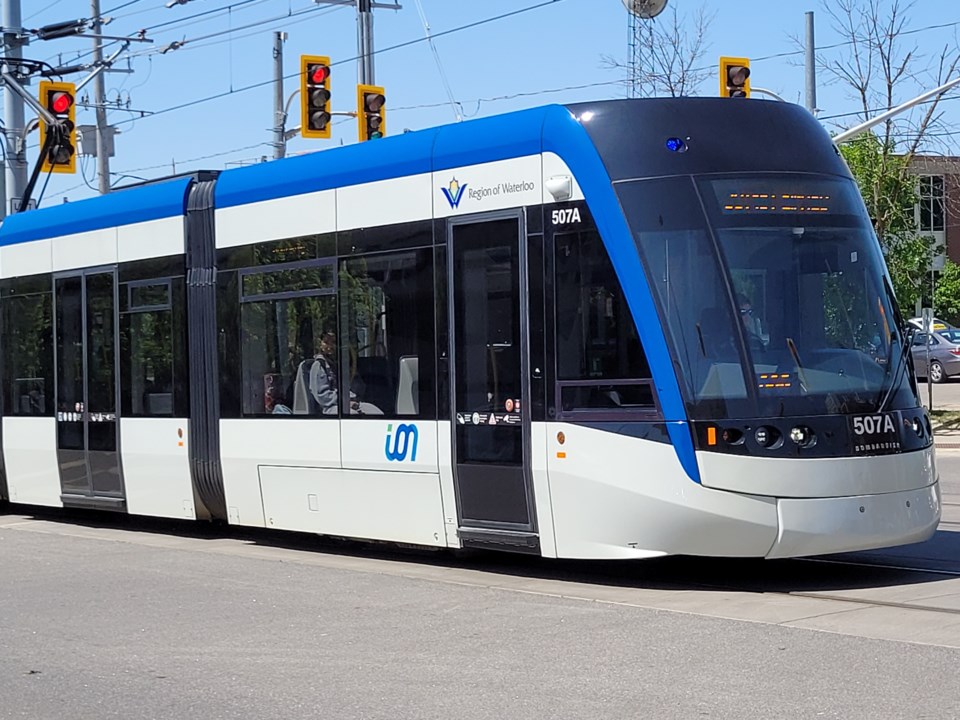Staff at the Region of Waterloo will begin crafting the business case for bringing ION to Cambridge now that the southern terminus for the light rail transit system has been decided.
This morning, regional councillors voted unanimously in favour of making the Ainslie Street Grand River Transit terminal the final stop on the Stage 2 route.
It scored the highest among several metrics determined by transportation staff, including having the least impact on traffic operations, presenting the least engineering challenges and integration with local bus service. The Ainslie terminal also scored high for its walkable radius to destinations people want to get to.
The full support for the Ainslie terminus included Cambridge Mayor Jan Liggett who had asked staff to look into the possibility of a Dundas and Main street terminus to support high density development planned for that part of the city.
The staff report on the idea, however, pointed to cost as the major hurdle for that location due to the added length of the track and the fact it would require far more expropriations than is required on Ainslie.
Building the terminal at Ainslie will cost an estimated $137 million while building the terminus at Main and Dundas would cost an estimated $245 million in today's dollars.
Liggett said that while she wanted the vote to be unanimous and supports the recommended location, she believes discounting Main and Dundas represents a missed opportunity to serve an area where "major growth is going to happen."
"These things tend to be in areas of business in downtown cores and I don't believe that is necessarily the best place to put these in every given community," she said.
She added she doesn't believe staff had enough time to fully evaluate it.
"I am happy to see that there will finally be connectivity for Cambridge with the rest of the region and I don't want to hold that up."
Support for the Ainslie Street terminus came from a number of delegations, including Sustainable Waterloo Region, the Downtown Cambridge BIA, Citizens for Cambridge and Pearle Hospitality, owners of the Cambridge Mill.
Councillor Pam Wolf said positioning the station at Ainslie Street will mean a lot to the residents, businesses and students of the University of Waterloo's School of Architecture, who wrote a letter in support saying many currently face 90 minutes of travel time between the Cambridge campus and UW and feel the ION would eliminate a significant barrier.
The discussion derailed around planning for a combined Pinebush LRT and GO train station with the understanding that a business case for a Cambridge to Guelph GO route is expected to come forward next March.
Matthew O’Neil, manager of rapid transit coordination with the region, said he is working on both projects and both are being studied independently of one another.
"They can work together, they are compatible, they're both being advanced, so I don't think it's necessary to tack GO train onto the Stage 2 ION initial business case," he said.
Commissioner of transportation services for the region Mathieu Goetzke agreed and urged council to wait for the spring report on the GO business case before determining the need for land acquisitions and other considerations in conjunction with the LRT.
"I think this is another significant step in getting the LRT to Cambridge and I hope the citizens of Cambridge and the region see this as an early Christmas gift," councillor Jim Erb said. "It's a major step in connecting our three urban centres. The city of Cambridge has been waiting for this for a long time and it's something they deserve. It can't happen fast enough."
Erb feels the ION will be a significant piece in removing the barrier presented by Highway 401.
O'Neil said the next steps for staff will be coming up with a terminal layout that will involve public consultation early next year with a recommendation for a preferred layout coming to council by next spring.
The business case will include several project alternatives and comparisons, including shortened routes ending at Pinebush, the Delta and the Ainslie terminal. It will also include a stand alone LRT option for Cambridge running between Pinebush and the Ainslie terminal and the option for a rapid bus transit route from Fairway Station to the Ainslie terminal.
The consultant for the Stage 2 initial business case will be awarded by April of next year and a complete business case will be complete by next December.
In two years, the region expects to have preliminary design and field investigations complete and a preliminary design business case.



